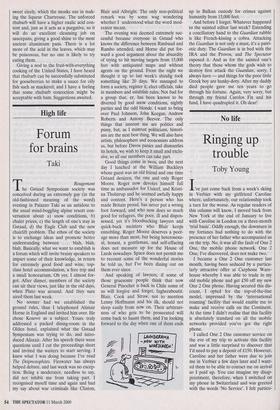Food for thought
Fruit or veg?
Simon Courtauld
Like most pubs, no doubt, the one I vis- ited last week had a machine in the Gentle- men's offering a variety of 'flavoured condoms'. Without wishing to make any comment whatsoever on this bizarre novel- ty (perhaps it is not a novelty), I was inter- ested to note that one of them was described as 'rhubarb and custard'. Regardless of the context, it was encourag- ing to know that rhubarb is apparently in popular demand these days — and it reminded me that the rhubarb season has come around again. March is surely the right month to start eating rhubarb which has been forced under straw and an upturned dustbin. Yet have noticed it on sale in Waitrose since early January. There is far too much out- of-season produce available these days, which I suppose means there must be peo- ple who want to eat strawberries and asparagus in the middle of winter. But I am not one of them. 'To every thing there is a season . . . a time to plant, and a time to pluck up that which is planted.' It may well be that the asparagus on sale during Jan- uary and February had just been plucked up from the fields of Peru and Ecuador; but that is not the point.
One point about rhubarb is whether it should be classified as fruit or vegetable. As a leaf stem it should presumably be called a vegetable, though I am told that a court in the United States has judged it to be a fruit. (This is of no great significance: the Americans use fruit indiscriminately in cooking, serving it up with meat, eggs, fish, where we would offer a vegetable or noth- ing at all. Last month in Texas I was given a shrimp omelette surrounded by melon.) Rhubarb was apparently introduced into Britain from Asia around the 16th century. For the next 300 years it was cultivated mainly by monks as a medicinal plant, and prescribed as a purgative. Augustus Hare recalled, as a boy in the mid-1800s, being given a dose of rhubarb and soda 'with a forcing-spoon . . to teach me to avoid such carnal indulgences as lollypops'. Something called Gregory's Powder, based on rhubarb, is also remembered by the older generation, especially for its flatulent effect. The Victorians enjoyed rhubarb in tarts and pies, but in the 20th century its popularity declined for several decades. Although I can remember eating rhubarb for most of my life, it did not feature on restaurant menus until quite recently.
Rhubarb is most easily grown from crowns, planted either in autumn or spring. It is scarcely known in Mediterranean cooking, perhaps because it needs a good cold spell in winter to promote its growth. Rhubarb is quintessentially English and here it is rightly regarded as the first fruit of spring. Some modern chefs — Delia Smith, Gary Rhodes — are quite willing to acknowledge its qualities in tarts, crumbles, pies and fools; a rhubarb fool, with pre- served ginger and cream, is quite delicious. I am also very partial to it stewed with yoghurt for breakfast. And once, when experimenting with an ice-cream maker, I mixed rhubarb and banana, to a chorus of approval from those who tried it. Rhubarb fritters, with cinnamon and a dollop of treacle, have been highly recommended, and I hope to try them this spring. Rhubarb jam is, or was, frequently made (with sugar, lemon juice, orange peel and ginger) and `rhubarb champagne' appears in an old cookbook.
If rhubarb is grown without any protec- tion, the redder, tougher stalks will need to be peeled and more sugar added in the cooking. They will taste less tart, and rather more interesting, if stewed with angelica or sweet cicely, which the monks use in mak- ing the liqueur Chartreuse. The unforced rhubarb will have a higher oxalic acid con- tent and, just as it acts as a purgative, so it will do an excellent cleansing job on saucepans, giving a good shine to the most ancient aluminium pans. There is a lot more of the acid in the leaves, which may be poisonous, but no one is likely to try eating them.
Giving a nod to the fruit-with-everything cooking of the United States, I have heard that rhubarb can be successfully substituted for gooseberries to make a sauce for oily fish such as mackerel; and I have a feeling that some rhubarb concoction might be acceptable with ham. Suggestions awaited.



































































 Previous page
Previous page